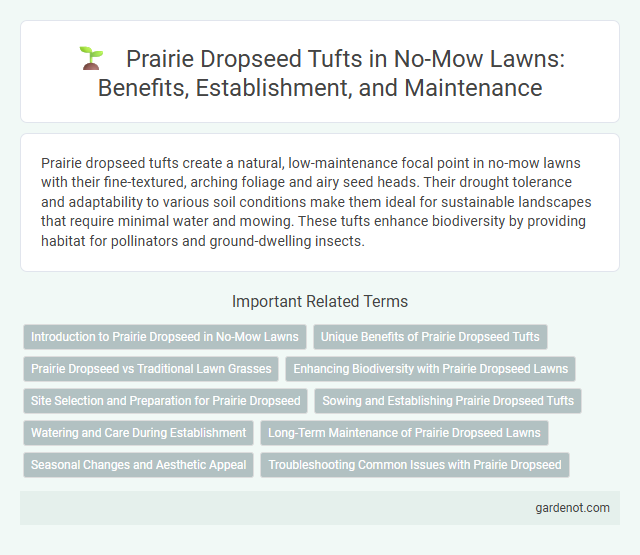Prairie dropseed tufts create a natural, low-maintenance focal point in no-mow lawns with their fine-textured, arching foliage and airy seed heads. Their drought tolerance and adaptability to various soil conditions make them ideal for sustainable landscapes that require minimal water and mowing. These tufts enhance biodiversity by providing habitat for pollinators and ground-dwelling insects.
Introduction to Prairie Dropseed in No-Mow Lawns
Prairie dropseed (Sporobolus heterolepis) is a native ornamental grass ideal for no-mow lawns due to its slow growth and fine-textured tufts. This drought-tolerant perennial forms dense clumps that reduce weed invasion and require minimal maintenance. Its airy seed heads add visual interest, enhancing biodiversity while promoting sustainable landscaping practices.
Unique Benefits of Prairie Dropseed Tufts
Prairie dropseed tufts enhance no-mow lawns by providing fine-textured foliage that remains tidy without mowing, reducing maintenance time and expenses. Their deep root systems improve soil health, promote drought resistance, and stabilize the lawn ecosystem naturally. These tufts also contribute to biodiversity by offering habitat and food sources for pollinators and beneficial insects throughout the growing season.
Prairie Dropseed vs Traditional Lawn Grasses
Prairie dropseed (Sporobolus heterolepis) forms dense, fine-textured tufts that require minimal mowing compared to traditional lawn grasses like Kentucky bluegrass or fescue. Its deep root system enhances drought tolerance and soil health, reducing water usage and maintenance needs. Unlike conventional turf, prairie dropseed promotes biodiversity and supports native pollinators, making it a sustainable alternative for eco-friendly landscaping.
Enhancing Biodiversity with Prairie Dropseed Lawns
Prairie dropseed lawns significantly enhance biodiversity by providing essential habitat and food sources for native pollinators and wildlife. The dense tufted growth of prairie dropseed improves soil health and supports a diverse ecosystem of beneficial insects and small mammals. Integrating prairie dropseed in no-mow lawns promotes ecological balance while reducing the need for chemical inputs and excessive maintenance.
Site Selection and Preparation for Prairie Dropseed
Prairie dropseed thrives best in well-drained soils with full sun exposure, making site selection critical for optimal growth. Preparing the site involves removing existing grasses and weeds through mowing or herbicide applications to reduce competition. Incorporating organic matter improves soil fertility and drainage, supporting the establishment of healthy prairie dropseed tufts.
Sowing and Establishing Prairie Dropseed Tufts
Prairie dropseed tufts thrive when sown in well-drained soil during early spring, ensuring optimal germination with consistent moisture and light soil coverage. Establishment typically requires patience, as seedlings develop slowly but form dense, fine-textured clumps that enhance no-mow lawn biodiversity. Proper site preparation, including weed control and minimal disturbance, significantly improves the success rate of prairie dropseed establishment.
Watering and Care During Establishment
Prairie dropseed tufts require regular watering to maintain consistent soil moisture during their establishment phase, typically for the first 6 to 8 weeks. Avoid overwatering by allowing the top inch of soil to dry out between waterings to prevent root rot. Once established, prairie dropseed is drought-tolerant and thrives with minimal supplemental irrigation.
Long-Term Maintenance of Prairie Dropseed Lawns
Prairie dropseed lawns require minimal long-term maintenance due to their drought tolerance and slow growth rate, significantly reducing mowing frequency. This native grass adapts well to poor soils and resists pests, further decreasing upkeep demands and promoting sustainable landscaping. Regular late-winter mowing or burning helps rejuvenate growth, maintaining lawn health without excessive intervention.
Seasonal Changes and Aesthetic Appeal
Prairie dropseed tufts exhibit vibrant seasonal changes, transforming from bright green leaves in spring and summer to rich golden and amber hues in autumn, enhancing garden aesthetics. Their fine-textured, arching foliage creates a graceful, airy appearance year-round, adding dynamic interest to no-mow lawns. In winter, dried seed heads and tuft structure provide subtle movement and ornamental appeal, maintaining landscape beauty through all seasons.
Troubleshooting Common Issues with Prairie Dropseed
Prairie dropseed often faces issues such as poor growth and browning due to improper watering or soil compaction, which restrict root development. Ensuring well-drained soil with adequate moisture levels helps prevent root rot and nutrient deficiencies. Regularly checking for pests like aphids and applying targeted treatments can maintain the health and vibrant appearance of the prairie dropseed tuft.
Prairie dropseed tuft Infographic

 gardenot.com
gardenot.com